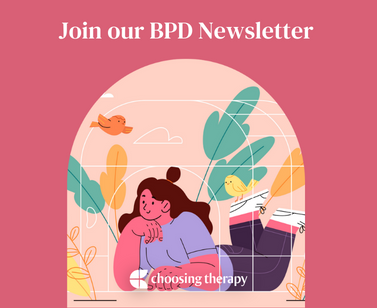Dialectical behavior therapy (DBT) for borderline personality disorder (BPD) is a long-term therapy that typically focuses on teaching mindfulness, interpersonal, and emotional regulation skills. DBT therapists help clients cope with emotional dysregulation, relationship issues, and other BPD symptoms by encouraging acceptance, embracing change, and addressing anger.
Therapy For Borderline Personality Disorder
BetterHelp has over 20,000 licensed therapists who provide convenient and affordable online therapy. BetterHelp starts at $65 per week. Take a Free Online Assessment and get matched with the right therapist for you.
What Is DBT for BPD?
Dialectical behavior therapy (DBT) for borderline personality disorder (BPD) models dialectical thinking (the idea that seemingly opposing truths can exist at the same time) and behaviors for clients. DBT therapists validate clients’ emotions and hold them accountable for their actions with positive and negative reinforcement.
DBT for BPD is a collaborative partnership, and therapists are encouraged to use self-disclosure to talk about their own experiences to strengthen the therapeutic alliance. Every session balances acceptance and change while nurturing and supporting certain behaviors.
An inpatient DBT setting provides more opportunities for positive attachment and intensive therapy.1 Both individual and inpatient approaches require one weekly individual session (sometimes two) and one weekly group session.
What Does Research Say About DBT for BPD?
In the early 1990s, Marsha Linehan established DBT as an effective treatment for BPD.2 Dialectical behavior therapy is considered the frontline treatment for BPD suicidality and self-harming behaviors.3 Substantial empirical research, including random control trials, has further supported the effectiveness of DBT for BPD.3
Recent MRI brain studies on women with BPD showed significant changes in participants’ gray matter after 12 weeks of DBT therapy.4 This important development demonstrates the future possibility of using neurobiologically informed therapy to treat borderline personality disorder.4
What to Expect From DBT for BPD
DBT for borderline personality disorder consists of several skill-building modules, including mindfulness, interpersonal effectiveness, distress tolerance, and emotional regulation. These techniques aid in the treatment of common symptoms of borderline personality disorder.
DBT treatment for BPD includes four stages–reducing negative behaviors and improving behavioral skills; treating issues related to past trauma; developing self‐esteem; and finding a higher purpose. Initially, the therapist and client will sign a contract for treatment outlining specific expectations.
Clients will also complete weekly diary cards documenting their behaviors. At this point, DBT therapists begin preparing clients for group sessions. Once placed in a group, clients must also continue attending weekly individual therapy.
DBT techniques for BPD include:
Mindfulness Meditation Skills
Mindfulness meditation teaches individuals to stay grounded in the here and now by remaining aware of the present, not the past or future. Those with BPD tend to have extreme emotions and can feel trapped in those emotions. Mindfulness for BPD can help individuals manage and cope with symptoms.5
Interpersonal Effectiveness Skills
Interpersonal skills help individuals fulfill their needs, nurture relationships, and improve their self-worth. Those with BPD can practice these when establishing appropriate boundaries for the situations and relationships they may be in.6
Distress Tolerance Skills
The distress tolerance skills used in DBT for BPD help clients cope when facing anger or turmoil. The goal is to prevent individuals from engaging in risky behaviors by developing a coping mechanism toolbelt. DBT distress tolerance skills help to mitigate reacting amid extreme anger, also known as borderline rage.6
Emotion Regulation Skills
Emotional regulation skills involve controlling one’s thoughts, feelings, and behaviors. For those with BPD, self-regulating emotions are challenging, possibly because of poor childhood experiences, trauma, or abuse. Using these DBT skills for BPD can make a big difference in how clients deal with stressful emotions they may have, as well as potential triggers.6
Help For BPD
Talk Therapy – Get help living with Borderline Personality Disorder from a licensed therapist. Betterhelp offers online therapy starting at $65 per week. Free Assessment
BPD Treatment For Teens & Young Adults – Charlie Health’s virtual mental health program for young people (ages 11-33) includes curated peer groups, individual therapy, and family therapy for teens and young adults with serious mental health issues. Insurance accepted. Learn More
DBT Skills Course – DBT is a popular treatment for BPD. Learn DBT skills with live weekly classes and online video courses. Free Trial
How Long Does DBT for BPD Last?
DBT for BPD can last anywhere from six months to two years. However, individuals may stay in treatment even longer if they find it helpful when working on goals and managing symptoms of BPD.
How Does DBT Help Those With BPD?
DBT for borderline personality disorder teaches clients skills to help manage their symptoms and build a healthy life. Emotion regulation skills allow them to process extreme emotions, while interpersonal effectiveness skills can help improve their relationships and self-respect.
Once individuals develop distress tolerance, they can approach challenging situations in healthy, productive ways. Finally, DBT mindfulness techniques can help them reduce stress and connect to themselves and others. Those with BPD can learn to avoid black-and-white thinking which often contributes to increased emotional dysregulation.
Below are some ways in which DBT can improve symptoms of BPD:
- Decreased suicidal thoughts and behaviors: Suicidal thoughts and behaviors may be an attempt to escape intolerable emotional suffering. DBT skills offer individuals new, more effective ways of coping with these intense emotions.
- Improved anger management skills: Intense anger can feel impossible to manage when you do not know how or when your environment reinforces your rage. Understanding, validating, and managing your anger with DBT skills can help reduce its intensity over time. These techniques offer more effective ways to act when you experience this emotion.
- Improved overall functioning: DBT techniques for BPD help improve overall functioning by teaching tools to tolerate inevitable challenges in life. DBT also helps assess your values and what may hinder you from pursuing them. You can then take action toward a fulfilling life.
- Improved ability to maintain relationships: Interpersonal effectiveness skills in DBT help patients identify their relational goals and communicate effectively to achieve those goals. DBT for BPD also teaches you how to manage your emotions and act more skillfully, which can help improve your relationships with yourself and others.
What If DBT for BPD Doesn’t Help?
There are many other BPD treatment options if you are not benefiting from dialectical behavior therapy for BPD. Interventions and therapies for borderline personality disorder can be beneficial, singularly or in tandem with DBT.
Below are therapy options that can help improve BPD symptoms:
- Cognitive behavioral therapy (CBT): CBT for BPD focuses on understanding thought distortions related to self and others.7 Other cognitive and behavioral approaches, such as acceptance and commitment therapy (ACT), can be helpful in distinguishing thoughts and behaviors from self and establishing parameters around identity.
- Schema-focused therapy: Schema-focused therapy helps people with BPD identify needs and understand how they meet these needs. Some research shows that those with BPD who participated in schema-focused therapy reported better self-understanding and improved emotional regulation.8
- Humanistic approaches: Humanistic therapy can help facilitate good outcomes in individuals with BPD, particularly due to its focus on client-therapist relationships. Humanistic approaches can assist clients in finding meaning in life and decrease BPD symptoms.9
- Family therapy: Due to the social discord and genetic/environmental causes associated with BPD, family therapy can be an important approach for long-term success. Researchers encourage better use of support systems in clients’ lives, and attending therapy together is one way loved ones can become more involved in a client’s treatment.10
- Mentalization-based treatment (MBT): Mentalization refers to our ability to understand our own and others’ mental states.11 MBT focuses on developing mentalization to reduce symptoms of BPD and enhance interpersonal functioning.11
- Good psychiatric management (GPM): GPM is a generalist therapeutic option that focuses on teaching and promoting “social adaptation.”12 GPM is a less intense option than DBT but can be effective in treating BPD.12
- Transference-focused therapy (TFP): Transference refers to a patient’s feelings about their therapist, and transference-focused psychotherapy uses this client-therapist relationship as a primary tool for treating BPD.13
- Short-term hospitalizations: Involuntary or voluntary hospitalization can keep someone with BPD safe when necessary. The goal of hospitalization is to assess one’s medication management, symptoms, and next steps to aid in stabilization.
How to Find a DBT Therapist for BPD
Asking for a referral from your primary care physician or using an online therapist directory can help you find the right therapist. You can filter your search for a DBT therapist, based on price, experience, and more. Feel free to ask a therapist about their education, training, certifications, and personal treatment philosophy. A good therapist can help you accomplish treatment goals in a safe, honest, and trustworthy environment.
Many therapists have online bios that include their areas of focus and specializations. Looking around for DBT therapists may take some time, but there are many who are increasingly utilizing DBT techniques for treating BPD.
Find a supportive therapist that can help with BPD.
BetterHelp has over 20,000 licensed therapists who provide convenient and affordable online therapy. BetterHelp starts at $65 per week. Take a Free Online Assessment and get matched with the right therapist for you.
Questions to Ask a DBT for BPD Therapist
Spend time getting to know a therapist during an initial phone consultation. Doing so will help you gauge the experience they have with BPD, as well as figure out if they’re a good personality fit for you.
Here are questions to ask a new therapist before starting DBT for BPD:
- How long have you been practicing DBT for BPD?
- How often do you meet with individuals, and how long are appointments?
- Do you have a crisis line or resources available?
- Do you offer contact between sessions? Phone sessions?
- What specialized DBT training do you have in treating BPD?
- On average, how long do you see individuals with BPD before they report improvements?
- Do you give therapy homework, and what might this look like?
- What struggles do people encounter when receiving this dialectical behavior therapy for BPD, and what do you encourage them to do when these happen?
Final Thoughts
If you or a loved one are dealing with unwanted symptoms of BPD, DBT could help you feel better and manage distress. The sooner you seek treatment, the better.
Additional Resources
Education is just the first step on our path to improved mental health and emotional wellness. To help our readers take the next step in their journey, Choosing Therapy has partnered with leaders in mental health and wellness. Choosing Therapy may be compensated for marketing by the companies mentioned below.
Talk Therapy
Online-Therapy.com Get support and guidance from a licensed therapist. Online-Therapy.com provides weekly video sessions and unlimited text messaging with your therapist for only $64/week. Get Started
BPD Treatment For Teens & Young Adults
Charlie Health’s virtual mental health program for young people (ages 11-33) includes curated peer groups, individual therapy, and family therapy for teens and young adults with serious mental health issues. Insurance accepted. Learn More
Free BPD Newsletter
A free newsletter from Choosing Therapy for those impacted by BPD. Get helpful tips and the latest information. Sign Up
DBT Skills Course
Jones Mindful Living Dialectical Behavior Therapy (DBT) is a popular treatment for BPD. Learn DBT skills with live weekly classes and online video courses for only $19 per month. Free One Week Trial
Choosing Therapy Directory
You can search for therapists by specialty, experience, insurance, or price, and location. Find a therapist today.
For Further Reading
- Personality Disorders Institute (PDI)
- Treatment and Research Advancements Association for Personality Disorder (TARA APD)
- Borderline Personality Disorder
- National Alliance on Mental Illness / Treatments
- Personality Disorders Resources
- Mental Health America Groups
- BPD Resources & BPD Support Groups Online
Best Online Therapy Services There are a number of factors to consider when trying to determine which online therapy platform is going to be the best fit for you. It’s important to be mindful of what each platform costs, the services they provide you with, their providers’ training and level of expertise, and several other important criteria. Best Online Psychiatry Services Online psychiatry, sometimes called telepsychiatry, platforms offer medication management by phone, video, or secure messaging for a variety of mental health conditions. In some cases, online psychiatry may be more affordable than seeing an in-person provider. Mental health treatment has expanded to include many online psychiatry and therapy services. With so many choices, it can feel overwhelming to find the one that is right for you.







